12 Essential Steps for Pre-Production Planning Checklist
by WriteSeen
A successful project starts with a rock-solid foundation, and that's where a pre-production planning checklist comes in. This essential guide streamlines your creative process, ensuring you focus on what matters.
Whether you're a filmmaker or a game developer, having this roadmap means fewer surprises and more time for innovation. Let’s get straight to the essentials for a seamless transition from concept to creation.
1. Lock the Shooting Script
Before diving into the complexities of pre-production, cementing the script is non-negotiable. This is your cinematic blueprint—get it right, and everything else will click into place. Analyze, refine, and vet every detail to keep everyone on set aligned.
-
Thorough Review: Comb through your script. Engage script advisors, editors, or mentors to uncover blind spots. Build a narrative that grips the audience and lays a foundation for the production process.
-
Secure Approvals: Directors, producers, and key personnel should universally endorse the script. This ensures collective agreement and avoids unnecessary tweaks in real-time production scenarios.
-
Eliminate Ambiguities: Clarity in storytelling translates to efficiency in production. Phrase directions and dialogues with precision, paving the way for actors and crew to perform without guesswork.
The locked script serves as the master guide. Every scene you shoot will draw from this central document, underscoring the importance of rigorous preparation.
2. Budget Finalization
Lay down a robust budget to keep the wheels of your production spinning smoothly. Thinking ahead financially can prevent unexpected hurdles.
-
Detailed Forecasting: Itemize every possible expense, from equipment rentals to talent fees. Always account for the unexpected. Padding your budget with contingency funds is wise.
-
Allocate Resources Wisely: Assign funds based on priority and necessity. Clever allocation ensures quality without financial strain, akin to a balanced creative ecosystem.
-
Maintain Transparency: Keep your financial backers in the loop. Transparency builds trust, and informed collaborators are typically more supportive in crunch times.
Securing a financial outline lays the groundwork for every future transaction and decision. It not only stabilizes but strengthens the production’s foundation.

3. Assemble Your Core Team
Gathering a dedicated core team is integral to translating vision into reality. With the right people in place, your project has the best chance of success.
-
Leadership Selection: Choose directors, producers, and department heads who understand and are enthused about your vision. Their excitement often percolates down to the rest of the team.
-
Fostering Diversity: A variety of backgrounds and skill sets mean enriched perspectives that fuel innovation.
-
Creating Alignment: Ensure your team shares key production objectives. When everyone moves in unison, workflow becomes seamless.
Building a strong team is a cornerstone for achieving a seamless production process. Each selected role fills a specific need, advancing the project’s unique narrative.
4. Conduct a Script Breakdown
Converting a script into actionable tasks starts with a script breakdown. This helps identify all the practical elements needed to bring scenes to life.
-
Identify Essentials: Isolate props, wardrobe requirements, and set pieces needed for each scene.
-
Resource Planning: Assign responsibilities and procure the needed materials. Ensure no essential elements go unnoticed.
-
Schedule Integration: Each element should fit cleanly into the production schedule, helping maintain efficiency on shoot days.
Reflecting the narrative intricacies into logistical specifics bridges the creative and operational aspects of your production.
5. Create a Storyboard
Crafting a visual rendition of the script allows for pre-visualization, saving time and minimizing errors once filming begins.
-
Visual Planning: Map out every scene to visualize narration, camera angles, and lighting. Storyboards offer a visual guide for achieving the director’s intended style.
-
Consistency Maintenance: Ensure the visuals remain true to the tone of the script. This guides your team in maintaining cinematic coherence across scenes.
-
Facilitate Communication: A storyboard acts as a visual reference that enhances crew interactions and decisions, from lighting setups to camera movements.
A storyboard turns abstract ideas into tangible plans, making it easier for all involved to translate vision into moving images.
6. Secure Locations and Permits
Finding the right filming spots can affect the authenticity and quality of the final product. But logistical issues and permits need to shape part of that consideration.
-
Location Scouting: Explore locations that enhance the story, considering vital factors like climate, access, and aesthetics.
-
Permits and Compliance: Engage with local authorities early to secure necessary permissions. Overlooking this could lead to costly interruptions or fines.
-
Logistics Planning: Consider transportation, accessibility, and on-site amenities. The smooth movement of the crew and equipment reduces downtime and enhances productivity.
Each carefully selected location adds a fresh layer to your narrative. Meticulous planning and permit management prevent location-based hassles.
7. Plan the Casting Process
Actors are the living, breathing essence of your film—casting shapes the viewer’s entire experience. Process efficiency transforming character concepts into on-screen presence is key.
-
Schedule Auditions: Structure a clear casting timeline. Coordinate with potential talent and ensure each step aligns with broader production timelines.
-
Character Alignment: Seek talent that embodies the nuances of each character. This step’s success lies in picking the right fits, ensuring authenticity and seamless integration into the story.
-
Foster Chemistry: Initial readings or chemistry tests between co-actors, especially those sharing intense or intimate scenes, are advisable. This encourages believable, engaging performances.
A systematic casting process enhances storytelling by bringing characters authentically to life. It's the bridge that transforms scripted personas into compelling on-screen performances.
8. Design the Production Schedule
A strategic production schedule is vital to orchestrate your project's many moving parts. This will keep the team on track and ensure resources are used optimally.
-
Timeline Construction: Break the schedule down by day and scene. Prioritize complex scenes to tackle when energy and focus are at their peak.
-
Allocate Resources: Sync filming with gear rental timelines. Efficient scheduling stretches budget without compromising quality or creativity.
-
Factor in Variables: Include buffer days for weather-related delays, reshoots, or unexpected hiccups. A well-built schedule anticipates the unpredictable.
With a structured schedule, everyone understands their roles, enhancing productivity and cohesion on set.

9. Rev Up the Art Department
The art department breathes stylistic life into the script. Guiding this team ensures the aesthetic vision is realized without constantly being pulled off course.
-
Clear Artistic Vision: Communication is key. Share your vision and encourage your team to innovate within those borders.
-
Resource Planning: Assign tasks based on skill, ensuring every team member plays to their strengths. This clarifies expectations and heightens the quality of output.
-
Sustainable Practices: Opt for eco-friendly set materials and practices. Today’s audiences value sustainability, and crafting with this in mind can enhance brand value.
The art department’s success lies in translating narrative themes into engaging visuals, maintaining coherence and style throughout.
10. Acquire Insurance
Protect your hard work by securing comprehensive insurance. Proper coverage shields your project from unforeseen risks, safeguarding your timeline and financial investment.
-
Identify Risks: Evaluate the unique needs of your production. Specific locations, stunts, or periods may require tailored coverage.
-
Engage Experts: Insurance professionals can guide policy selection ensuring all bases are covered, from equipment damage to crew liabilities.
-
Compare Options: Weigh different policies. Policies should be flexible, covering the scope and scale of potential damages.
Implementing reliable insurance ensures peace of mind, allowing focus to remain on creative elements instead.
11. Schedule Rehearsals
Rehearsals are crucial for honing performance, synchronizing cast and crew, and spotting potential logistic hurdles before production kicks off.
-
Regular Sessions: Host rehearsals for specific scenes or sequences ahead of filming days, tackling challenging aspects early.
-
Evaluate Dynamics: Test character interactions. Ensure tension, rapport, and chemistry translate authentically on screen.
-
Technical Rehearsals: Allow crews to trial equipment setups for specific shots, minimizing technical issues when filming.
The time spent on rehearsals amplifies the production’s quality and ensures smooth operational flow once the cameras roll.

12. Conduct a Technical Scout
Ensure your location meets all technical needs before a single shot is filmed. This walkthrough will identify and resolve limitations beforehand.
-
Detailed Evaluation: Review power sources, sound quality, and lighting potential at each location.
-
Test Equipment: Trial key gear to ensure environmental factors don’t skew performance. Make necessary adjustments in advance.
-
Optimize Workflow: Map out an efficient workflow. This involves pick-up/drop-off points for gear, crew logistics, and contingency plans for variable conditions.
Technical scoping acts as preventive maintenance—reducing downtime and avoiding costly fixes mid-production.
Pre-Production and Beyond
A tightly structured pre-production workflow streamlines the path to production. Engaging all critical elements ensures a holistic, adaptable approach, preparing each team member for their specific role. This approach equips you to transition smoothly into production, maximizing creativity and resource allocation.
-
Communication: Keep lines open, ensuring pitches lead to projects, much like how creators connect on our platform for peer feedback.
-
Agility: Adapt techniques and tech for shifting needs—effective pre-production lays a strong foundation you can build upon.
-
Tech Integration: Utilize advanced tools for project management and coordination, mirroring our own integrated workflow for efficient collaboration.
Stick to the outlined steps for smooth and proactive transitioning, funneling energy towards the heart of your goals.
Conclusion
Achieving creative success requires strategic planning, from script lock to final technical scout. Implementing a comprehensive pre-production checklist ensures every aspect serves the project's vision. Engage your resources, keep communication open, and your project will be more than prepared for the challenges and triumphs of production. Following this guide, your story can unfold with precision and impact, resonating with audiences and stakeholders alike.
TAGS